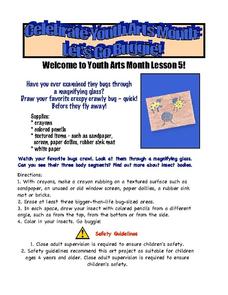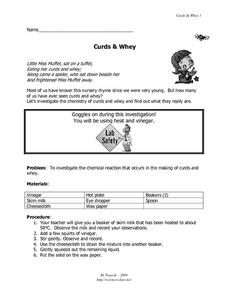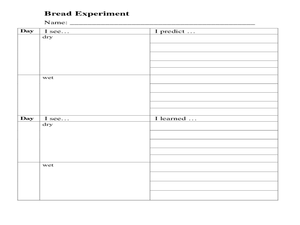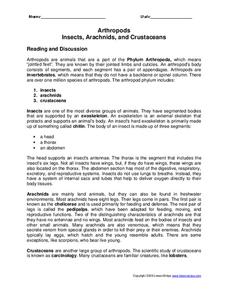Arts & Humanities
Let's Go Buggie!
To celebrate art youth month, little ones get out the magnifying glasses and get close-up with bugs. They make scientific observations of bugs you bring into the classroom. Then, they use markers, clay, paint, or crayons to make artistic...
New South Wales Department of Education
Invertebrates
Of all invertebrates, insects by far are the most numerous. Scholars discuss invertebrates and then use a key to classify them. They see different examples and must describe features of each organism based upon the key.
Biology Junction
Water, Solutions, pH, and Buffers
What common chemical includes safety warnings for being harmful if swallowed or inhaled, causes serious eye damage, and needs to be cleaned up immediately if spilled on the floor? Surprisingly, the dangerous chemical turns out to be...
Biology Junction
World of Insects: Characteristics, Orders, and Collecting
Every bug is an insect, but not all insects are bugs. A presentation lists the characteristics of insects, describes their body parts, and explains metamorphosis. It also details every order and includes photographs and multiple facts...
Curated OER
Insects and Bugs
Students recognize the difference between insects and bugs while making connections to personal experiences. In this insect and bug lesson, students complete a pre-assessment to demonstrate prior knowledge, then gather information...
GiggleUp Kids
Happy Little Farmer
Pre-readers and primaries can help farmer rabbit to plant some delicious fruits and vegetables. From soil preparation and pest control, all the way to the harvest, little ones participate in the entire process!
Curated OER
Research Project
Pupils learn the characteristics of arachnids by researching the arachnid of their choice and producing a 4 to 5 paragraph research paper.
Curated OER
Types of Behavior
In this science instructional activity, students analyze specific animal and human behaviors and classify them as innate or learned. Students answer 20 questions, identifying behaviors and explaining how they are helpful to the animal....
Curated OER
Primate Evolution
In this primate evolution worksheet, high schoolers will review the structures and functions that are characteristic of primates. Students will identify the differences between Old World monkeys, New World monkeys, and prosimians. This...
Curated OER
Layers of the Forest- Leaf Litter
Students conduct an experiment. In this temperate forest instructional activity, students discuss what kind of animal life can be found in the forest. They read The Magic School Bus Meets the Rot Squad: A Book About Decomposition and...
Curated OER
Arthropods
For this arthropods worksheet, students will identify 3 different arthropods and compare these organisms' breathing structures: gills, book lungs, and tracheal tubes. This worksheet has 3 fill in the blank and 6 short answer questions.
Curated OER
Curds and Whey
For this chemical reaction worksheet, students investigate the reaction that makes curds and whey. They mix milk and vinegar and run it through cheesecloth to collect the solid. Students make observations, read about curds and whey, and...
Curated OER
Forest Decomposition
Students explore decomposition. Students define and describe components of the decomposition process. Students make a composter in a terrarium. Students record observations and changes weekly, drawing conclusions about the results...
Curated OER
Arthropods, Insects, Arachnids, and Crustaceans
In this biology worksheet, students read about arthropods and some of the different species that fit into this classification. They then answer 13 questions about what they just learned. The answers are on the last page of the packet.
Curated OER
Name that animal
A great way to classify organisms, is by counting the number of legs it has or how it moves. Little ones count the legs on five different creatures, then match the leg count to the proper animal name. Tip: Have them come up with other...
Curated OER
Living it up with plants
Have kids in grades K-2 discuss how they know a tree is alive. The worksheet provides simplistic background information and an observation check list. They check off the ways that they can tell an oak tree is a living thing. Note: The...
Curated OER
Classifying Shells
Young scholars observe and classify different types of shells. They compare and contrast an exhibit they created with one that already exists in a musuem. They discover the different characteristics of shells.
Curated OER
Habitat Happenings
Students examine the characteristics of the Prairie Creek Habitat in Illinois. In groups, they travel between various stations writing haikus and reading brochures. They identify what occurs in each habitat and identify the animals...
Curated OER
Prairie Predator and Prey
Fifth graders brainstorm a list of animals that live on the prairie, and classify them as predators and prey. They conduct interviews where they ask the animals what they need to look out for to sustain life on the prairie.
Curated OER
Growing Garden Companions.
Students understand that some plants grow better with other plants. In this companion planting lesson, students observe the "three sisters" growing system used by the Native Americans. Students understand that small gardens grow better...
Curated OER
Creating a Family - Arthropods
Fifth graders make model and write essay of a new family pf arthropods using known data.
Curated OER
Animals in the Media
Sure to activate young minds, this resource asks learners to consider how media influences their personal points of view. Pupils examine how animals are portrayed in the media to understand why they feel the way they do about those...
Curated OER
4-H Entomology Project: Insect Collections
Set your students on an exploration of insects with this resource. Learners can get ideas for experiments, investigations and much more. There are five tips for insect collection.
Curated OER
'Don't Let the Bugs Bite' Word Search
In this bugs word search learning exercise, learners locate and identify 25 insect-related words within the word search puzzle.
Other popular searches
- Spiders and Science
- Life Science Spiders
- Science Spiders vs Insects
- Earth Science Spiders
- Elementary Science Spiders
- Physical Science Spiders























